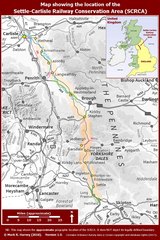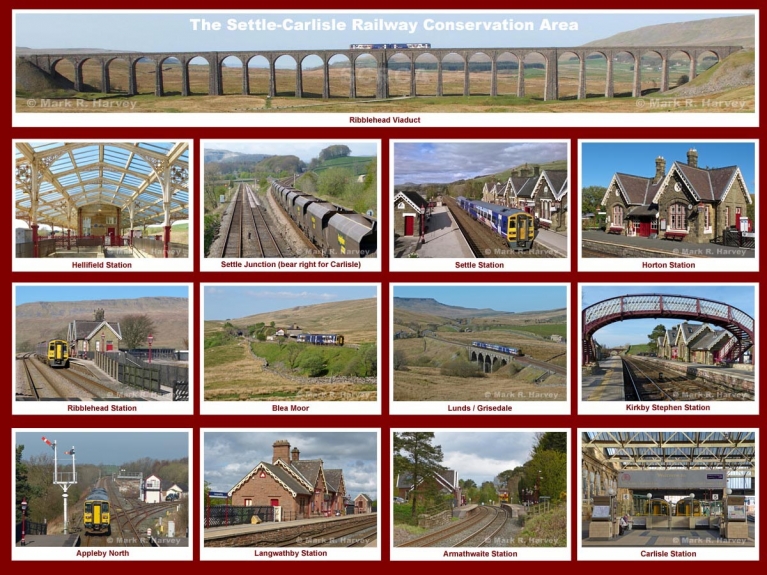Welcome to the
Settle-Carlisle Railway Conservation Area
web-portal
The SCRCA
The Settle-Carlisle Railway Conservation Area (SCRCA) is a 78-mile section of mainline railway in northwest England that is considered to be an area of special architectural and historical interest.
In a bid to preserve the character and appearance of this historically important section of Britain's national rail network, it was officially designated a conservation area in 1991.
It is the longest conservation area in the United Kingdom and it covers the entire railway (including all of the associated historic structures) between Hellifield Junction in North Yorkshire and Carlisle Citadel Station in Cumbria.
The adjacent map shows the location of the SCRCA and the photo-montage below gives a flavour of what the conservation area has to offer.
As evidenced by the photographs in the montage below, this fascinating railway passes through - and provides easy access to - some of the most attractive and dramatic scenery in England.
The Settle-Carlisle Railway Conservation Area:
architecture and landscape in perfect harmony.
Grand Tours
If you've plenty of time, make yourself comfortable, then use one of the links below to take a virtual grand tour of the entire conservation area:
- Virtually Visit the key operational sites and standing structures within the SCRCA.
- Virtually Explore the SCRCA using interactive maps or aerial imagery.
- Delve into the details via the comprehensive Gazetteer.
Heritage Hotspots
If you've limited time, or if you're seeking ideas for a real-world visit, check-out the following 'highlight' locations. They're all easily accessible by train.
- Heritage Hotspot 1: Hellifield Station
- Heritage Hotspot 2: Settle
- Heritage Hotspot 3: Horton Station
- Heritage Hotspot 4: Ribblehead and Blea Moor
- Heritage Hotspot 5: Dent Station
- Heritage Hotspot 6: Garsdale
- Heritage Hotspot 7: Kirkby Stephen Station
- Heritage Hotspot 8: Appleby
- Heritage Hotspot 9: Langwathby Station
- Heritage Hotspot 10: Lazonby and Kirkoswald Station
- Heritage Hotspot 11: Armathwaite Station
- Heritage Hotspot 12: Carlisle Citadel Station
Background Reading
A series of general articles accompanies and expands upon the location-specific information.
The SCRCA Project
The goal of the SCRCA Project is to facilitate and encourage the interpretation and public enjoyment of the Settle-Carlisle Railway Conservation Area and to provide an information resource that will assist those responsible for managing it.
However, it is important to stress that, as independent volunteers, our role is purely supportive. We have no direct responsibility or liability for any part of the conservation area or for any of the structures located within it.
If you'd like to learn more about the SCRCA Project, start with the Introduction and Overview page.
To learn more about conservation areas generally and the reasoning behind the SCRCA Project, see the Background and Context page.
The SCRCA Project is entirely dependent on volunteers and other contributors. If you think you might be able to help us, please refer to the Plea for Information and Images and Getting Involved pages in the first instance.
If you'd like to get in touch with the SCRCA Project team, you can use the web-portal to Contact Us.
The SCRCA Showcase
(a.k.a. What's new?)
New location-specific images and brief snippets of location-specific information are uploaded to the SCRCA web-portal on an occassional basis and they appear automatically in the relevant location summaries. However, for the benefit of our regular virtual visitors, they can also be accessed 'out of context' via the following pages:
New location summary introductions, location-related snippets, background articles and special image collections are also uploaded from time to time. The most noteworthy recent additions are listed below (with the most recent at the top of the list).
1 September 2025
A brief introduction has been added to the Location Record for Ais Gill signal box and the short snippet relating to the box's relocation to Butterley has been significantly expanded. As part of this process, three new snippets have been created:
- Correspondence relating to the purchase of Ais Gill signal box by the Midland Railway Trust.
- Article from Steam World Magazine entitled "The Saving of Ais Gill Signal Box".
- Article entitled "The Ais Gill signalbox" from the Wyvern journal.
21 August 2025
New Location Records (Gazetteer Entries) have been created for Horton Quarry and its New Rail Link and a set of photographs have been uploaded for each one.
17 August 2025
A new contemporary account article entitled "The official opening of the Settle & Carlisle Railway for goods traffic" has been added.
30 June 2025
A new snippet "Memories of Lazonby Sand Pit Sidings from W.R. Mitchell's books" has been added.


